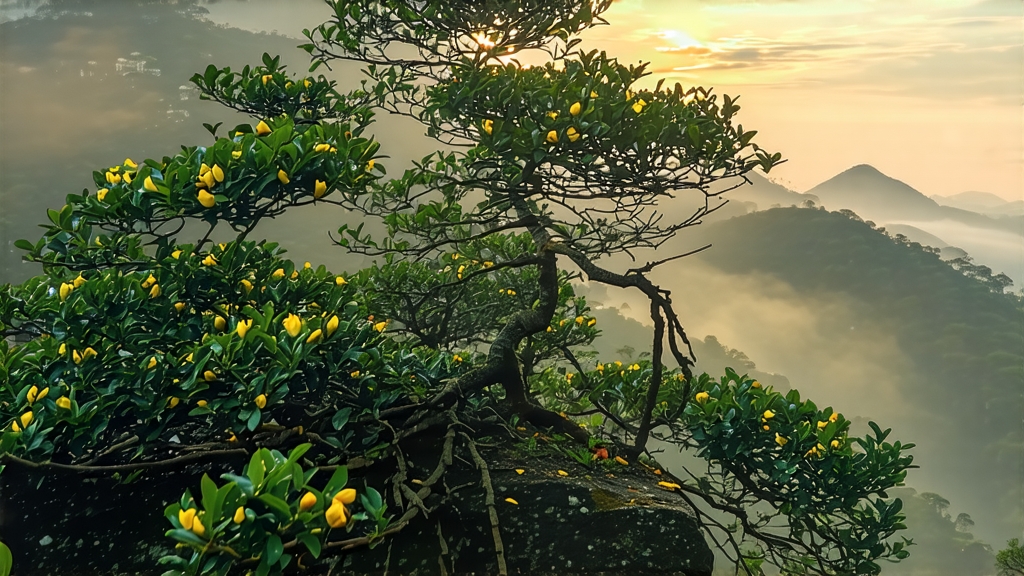
High among the cloud-veiled ridges of Sichuan’s Ya’an region, the legendary Mengding Mountain has been sending spring’s first yellow buds to emperors for more than twelve centuries. Today those same buds—known in the West only to a handful of connoisseurs—still carry the mellow, chestnut-sweet perfume that once graced the porcelain cups of Tang-dynasty poets and Song-court astronomers. To understand Mengding Huangya is to step into a living manuscript of Chinese tea history, one whose pages are still being written by mist, mineral soil, and the patient hands of a few hereditary tea masters.
Historical whispers
The story begins in 724 CE, when the monk Wu Lizhen planted seven tea bushes on the summit of Mengding, an act recorded in the county annals as the first deliberate tea garden in China. By the Song dynasty the buds were so coveted that a special courier road—faster than the imperial post—was carved through the Min River gorges so the tender shoots could reach the capital within five days of plucking. A Ming-era edict declared the entire mountain a “forbidden garden”; commoners who trespassed risked beheading. When the last Qing emperor abdicated in 1912, the tribute system collapsed, and Mengding Huangya retreated into local memory, produced only in quantities sufficient for Sichuanese scholars and the occasional Tibetan lama. Its renaissance began in 1959, when a team from the China Tea Research Institute rediscovered ancient groves and persuaded three surviving masters to teach the secret “sealed yellowing” technique to a new generation.
Micro-terroir on the roof of Sichuan
Mengding rises to 1 456 m, pushing through a permanent cloud belt that acts like a giant silk diffuser. Morning mist refracts ultraviolet light, slowing photosynthesis and coaxing the leaves to stockpile amino acids—especially theanine, which translates into the tea’s hallmark brothy sweetness. The soil is a crumbly quartz-rich phyllite that drains in minutes yet holds just enough moisture to keep the roots cool. Even in midsummer the temperature never exceeds 26 °C, so the bushes behave as if perpetually in early spring, yielding tiny, jade-colored buds no longer than a knuckle joint.
Three grades, one mountain
Unlike many Chinese teas that sprawl across whole provinces, authentic Mengding Huangya is produced within a 12 km radius of the summit. Within this micro-zone the leaf is classified into three ascending grades:
• Imperial Tip (黄芽皇): 100 % single buds picked before Qingming festival, giving a liquor the color of chrysanthemum honey and a scent of grilled sweetcorn.
• Golden Sparrow (金雀): one bud and one just-unfurling leaf, yellowed slightly less, offering a greener, more orchid-like fragrance.
• Gentle River (雅江): one bud and two leaves, allowed a longer oxidation phase, yielding a lighter cup with a hint of fresh fava bean.
Each grade follows the same arc of craft, but the duration and temperature of the critical “men huang” (sealed yellowing) step are adjusted like the stops on a flute, producing markedly different symphonies.
The invisible craft: sealed yellowing
After a 30-second wok roast at 160 °C to kill green enzymes, the leaves are immediately wrapped in stacks of hand-woven yellow kraft paper and slid into a bamboo steam chamber kept at 28 °C and 75 % humidity. There they rest, untouched, for 48 to 72 hours. During this quiet interval chlorophyll quietly degrades, polyphenols oxidize just enough to shed grassiness, and a golden pigment—unique to yellow teas—forms on the bud’s downy tip. The master judges readiness not by clock but by aroma: when the pile exhales the scent of fresh walnut and cooked rice, it is swiftly unwrapped and given a final low-temperature bake. The entire process consumes eight days, during which the leaf loses 94 % of its weight yet gains a flavor that can linger through seven infusions.
Water, fire, and patience: how to brew
Mengding Huangya is shy; it rewards calm water and a slow hand. Begin with a tall glass or a 150 ml gaiwan so the upright buds can be admired. Use 3 g of leaf—about thirty buds—for every 150 ml of water. Bring spring water to 85 °